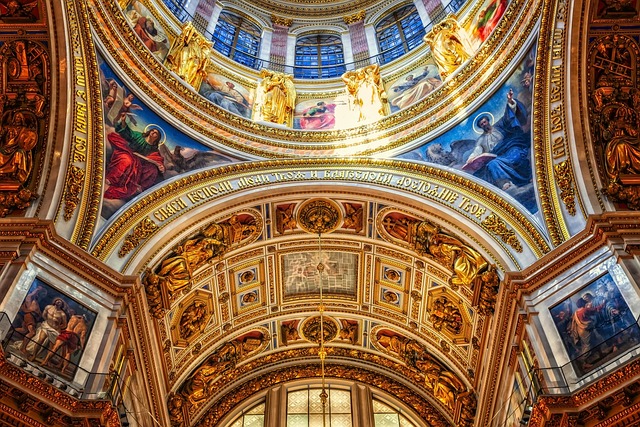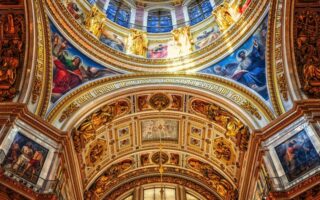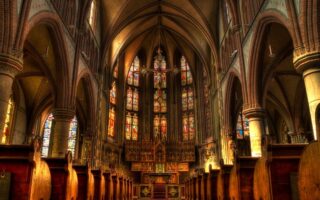Orthodox worship refers to the religious practices and rituals followed by the Eastern Orthodox Church. It is characterized by its rich liturgical tradition, deep spirituality, and adherence to ancient customs and teachings. Orthodox worship is centered around the Eucharist, or Holy Communion, and includes various prayers, hymns, and sacraments. The worship services are conducted in a reverent and symbolic manner, aiming to create a sacred atmosphere and facilitate a profound encounter with God.
Table of Contents
The Significance of Icons in Orthodox Worship
Icons play a significant role in Orthodox worship, serving as windows into the divine and connecting believers to the spiritual realm. These sacred images are not mere decorations but are revered as powerful tools for prayer and meditation. In this article, we will explore the significance of icons in Orthodox worship and how they enhance the spiritual experience for believers.
One of the key aspects of Orthodox worship is the veneration of icons. Unlike in some other Christian traditions, where icons may be seen as optional or even discouraged, Orthodox Christians hold them in high regard. Icons are considered to be windows into heaven, allowing believers to glimpse the divine presence. They are seen as a means of communication between the earthly and the heavenly realms.
When entering an Orthodox church, one is immediately struck by the abundance of icons adorning the walls. These images depict various saints, biblical scenes, and events from the life of Christ. Each icon is carefully crafted, following specific guidelines and traditions. The colors, gestures, and expressions of the figures are all carefully chosen to convey spiritual truths and inspire devotion.
Icons are not worshipped in the same way that God is worshipped, but they are venerated as holy objects. Orthodox believers understand that the true object of worship is God alone, but icons serve as aids in focusing their prayers and thoughts. They are seen as reminders of the presence of God and the saints, who are believed to intercede on behalf of believers.
The act of venerating an icon involves various rituals and gestures. When approaching an icon, believers may make the sign of the cross, kiss the icon, or bow before it. These actions are not meant to worship the physical object but to show reverence and honor to the person or event depicted. By physically engaging with the icon, believers are able to connect more deeply with the spiritual reality it represents.
Icons are also used as aids in personal prayer and meditation. Many Orthodox Christians have a small icon corner in their homes, where they can retreat for quiet contemplation. These personal icon corners often include candles, incense, and other items to create a sacred atmosphere. By focusing on an icon during prayer, believers are able to direct their thoughts and intentions towards God and the saints.
The use of icons in Orthodox worship is deeply rooted in tradition and history. The veneration of icons can be traced back to the early centuries of Christianity, and it has remained an integral part of Orthodox spirituality ever since. Icons are seen as a tangible link to the early Christian Church and the faith of the apostles.
In conclusion, icons hold great significance in Orthodox worship. They are not mere decorations but are revered as powerful tools for prayer and meditation. Icons serve as windows into the divine, connecting believers to the spiritual realm. Through veneration and personal engagement with icons, Orthodox Christians are able to deepen their connection with God and the saints. Icons are a tangible link to the early Christian Church and a cherished part of Orthodox spirituality.
Understanding the Divine Liturgy in Orthodox Worship

Orthodox worship is a rich and vibrant experience that has been passed down through generations. At the heart of this worship is the Divine Liturgy, a sacred and solemn service that brings believers closer to God. Understanding the Divine Liturgy is essential for anyone seeking to fully engage in Orthodox worship.
The Divine Liturgy is a carefully choreographed service that follows a set order. It begins with the Proskomedia, a preparation ritual where the bread and wine are prepared for the Eucharist. This is a time of quiet reflection and prayer, as the priest prepares himself and the elements for the sacred meal.
Once the Proskomedia is complete, the Divine Liturgy moves into the Liturgy of the Catechumens. This is the first part of the service where the congregation actively participates. Hymns are sung, prayers are offered, and readings from the Scriptures are shared. It is a time of learning and preparation, as the faithful prepare their hearts and minds to receive the Word of God.
After the Liturgy of the Catechumens, the service transitions into the Liturgy of the Faithful. This is the most sacred part of the Divine Liturgy, where the Eucharist is celebrated. The bread and wine, now consecrated, are believed to become the body and blood of Christ. This is a profound and deeply spiritual moment for Orthodox believers, as they partake in the mystery of the Eucharist.
Throughout the Divine Liturgy, there are various rituals and gestures that are performed. These rituals are not mere formalities, but rather meaningful actions that help to deepen the worship experience. For example, the sign of the cross is made frequently, as a reminder of Christ’s sacrifice and a symbol of faith. Bowing and prostrations are also common, as acts of humility and reverence before God.
In addition to the rituals, the music of the Divine Liturgy is an integral part of the worship experience. Orthodox hymns are known for their beauty and depth, often sung in a cappella harmony. The melodies and lyrics are carefully chosen to enhance the worship experience and draw believers closer to God. The music creates an atmosphere of reverence and awe, allowing worshippers to enter into a state of prayerful contemplation.
Attending a Divine Liturgy can be a transformative experience, but it can also be overwhelming for those unfamiliar with Orthodox worship. However, newcomers need not feel intimidated. Orthodox communities are known for their warm and welcoming nature, and they are always eager to help newcomers navigate the service.
If you are attending a Divine Liturgy for the first time, it is helpful to arrive a few minutes early to familiarize yourself with the surroundings. You may notice that the church is adorned with icons and candles, creating a sacred atmosphere. Take a moment to light a candle and offer a prayer before finding a seat.
During the service, it is perfectly acceptable to stand or sit as you feel comfortable. If you are unsure of when to stand or sit, simply follow the lead of those around you. Don’t worry about getting everything right the first time – the most important thing is to be present and open to the experience.
As the Divine Liturgy unfolds, allow yourself to be immersed in the beauty and reverence of the service. Listen to the hymns, join in the prayers, and observe the rituals. Let the words and actions of the liturgy guide you into a deeper connection with God.
Orthodox worship is a journey of the soul, a sacred dance between the human and the divine. Through the Divine Liturgy, believers are invited to participate in the timeless mysteries of the faith. So, whether you are a lifelong Orthodox Christian or a curious seeker, take the time to understand and appreciate the Divine Liturgy – it is a gateway to a deeper understanding of God’s love and grace.
Exploring the Role of Incense in Orthodox Worship
Orthodox worship is a rich and vibrant experience that engages all the senses. From the moment you step into an Orthodox church, you are enveloped in a world of sights, sounds, and smells that transport you to a different time and place. One of the most distinctive elements of Orthodox worship is the use of incense.
Incense has been an integral part of Orthodox worship for centuries. Its use dates back to ancient times, when it was used in both religious and secular settings. In the Orthodox Church, incense is seen as a symbol of the prayers of the faithful rising up to heaven. It is also believed to purify the air and create a sense of reverence and awe.
During an Orthodox service, the priest or deacon swings a censer filled with burning incense throughout the church. As the smoke fills the air, it creates a mystical atmosphere that enhances the worship experience. The scent of the incense is often described as sweet and fragrant, adding to the sensory richness of the service.
The use of incense in Orthodox worship is not just for aesthetic purposes. It also has a deeper spiritual significance. The smoke from the incense is seen as a representation of the Holy Spirit, who is believed to be present in the church during the service. As the incense rises, it is a visual reminder of the prayers of the faithful ascending to heaven.
In addition to its symbolic meaning, incense also has practical benefits. The smoke from the incense helps to mask any unpleasant odors that may be present in the church. It also has antimicrobial properties, which can help to purify the air and prevent the spread of germs. This is especially important in a crowded church setting, where people are in close proximity to one another.
The use of incense in Orthodox worship is not limited to the church building. Many Orthodox Christians also use incense in their personal prayer life. They may burn incense in their homes or carry a small censer with them when they travel. This allows them to create a sacred space wherever they go and to connect with God through the use of incense.
While the use of incense in Orthodox worship is deeply rooted in tradition, it is not without controversy. Some people find the smell of incense overpowering or have allergies that are triggered by it. In recent years, there has been a movement towards using less incense in Orthodox services to accommodate these concerns. However, for many Orthodox Christians, the use of incense is an essential part of their worship experience and a connection to their ancient faith.
In conclusion, the use of incense in Orthodox worship is a multi-sensory experience that adds depth and meaning to the service. It is a symbol of the prayers of the faithful rising to heaven and a representation of the Holy Spirit. The sweet scent of the incense creates a mystical atmosphere and enhances the worship experience. While it may not be for everyone, for many Orthodox Christians, the use of incense is an integral part of their worship and a connection to their ancient faith.
The Importance of Chanting and Hymnody in Orthodox Worship
Orthodox worship is a rich and vibrant experience that engages all the senses. From the moment you step into an Orthodox church, you are enveloped in a world of sights, sounds, and smells that transport you to a different time and place. One of the most important aspects of Orthodox worship is the use of chanting and hymnody, which play a central role in creating a sacred atmosphere and connecting worshippers to the divine.
Chanting has been an integral part of Orthodox worship since the early days of the Church. It is a form of musical prayer that combines melody and text to create a powerful and transformative experience. The melodies used in Orthodox chanting are ancient and have been passed down through generations of worshippers. They are often characterized by their haunting beauty and intricate harmonies, which can transport listeners to a place of deep spiritual contemplation.
The use of chanting in Orthodox worship serves several important purposes. First and foremost, it helps to create a sense of unity among the worshippers. When everyone is singing the same melodies and following the same rhythm, it creates a feeling of togetherness and shared purpose. This sense of unity is further enhanced by the fact that chanting is typically done in unison, with everyone singing the same notes at the same time. This creates a powerful sense of community and helps to foster a deep connection between the worshippers.
Chanting also serves as a form of prayer in Orthodox worship. The texts that are chanted are often taken directly from the Bible or from the writings of the Church Fathers. By singing these texts, worshippers are not only expressing their devotion to God, but also meditating on the profound truths contained within them. The repetitive nature of chanting allows the words to sink deep into the soul, helping to create a sense of inner stillness and peace.
In addition to chanting, hymnody also plays a significant role in Orthodox worship. Hymns are poetic expressions of faith that are sung by the entire congregation. They are often characterized by their rich imagery and profound theological insights. Hymns are typically sung in a call-and-response format, with a cantor or choir singing a verse and the congregation responding with a refrain. This creates a dynamic and interactive worship experience that engages everyone present.
The use of hymnody in Orthodox worship serves several important purposes. First and foremost, it helps to teach and reinforce the teachings of the Church. Many hymns are filled with theological truths and biblical references, which help to deepen the understanding of worshippers and strengthen their faith. Hymns also serve as a form of praise and thanksgiving, allowing worshippers to express their love and gratitude to God.
In conclusion, chanting and hymnody are essential elements of Orthodox worship. They create a sacred atmosphere, foster a sense of unity among worshippers, and serve as a form of prayer and praise. Whether you are a lifelong Orthodox Christian or someone who is curious about the faith, experiencing the power of chanting and hymnody in Orthodox worship is an experience that is sure to leave a lasting impression. So, next time you find yourself in an Orthodox church, take a moment to listen to the beautiful melodies and join in the singing. You may just find yourself transported to a place of deep spiritual connection and awe.
Conclusion
Orthodox worship is characterized by its rich and ancient traditions, deeply rooted in the early Christian Church. It is centered around the Eucharist, or Holy Communion, which is considered the pinnacle of the worship service. The liturgy is highly structured and follows a set order, with prayers, hymns, and readings from the Bible. Icons play a significant role in Orthodox worship, serving as windows to the divine and aids in prayer. The use of incense, candles, and vestments adds to the sensory experience of worship. Overall, Orthodox worship is a reverent and mystical encounter with God, aiming to unite believers with the divine presence.



